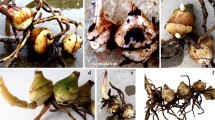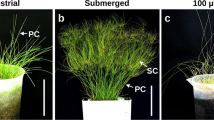Abstract
In this study, we examined the effects of ethylene and abscisic acid (ABA) upon heterophyllous leaf formation of Ludwigia arcuata Walt. Treatment with ethylene gas resulted in the formation of submerged-type leaves on terrestrial shoots of L. arcuata, while treatments with ABA induced the formation of terrestrial-type leaves on submerged shoots. Measurement of the endogenous ethylene concentration of submerged shoots showed that it was higher than that of terrestrial ones. In contrast, the endogenous ABA concentration of terrestrial shoots was higher than that of submerged ones. To clarify interactions of ethylene and ABA, simultaneous additions of these two plant hormones were examined. When L. arcuata plants were treated with these two plant hormones, the effects of ABA dominated that of ethylene, resulting in the formation of terrestrial-type leaves. This suggests that ABA may be located downstream of ethylene in signal transduction chains for forming heterophyllous changes. Further, ethylene treatment induced the reduction of endogenous levels of ABA in tissues of L. arcuata, resulting in the formation of submerged-type leaves. Thus the effects of ethylene and ABA upon heterophyllous leaf formation are discussed in relationship to the cross-talk between signaling pathways of ethylene and ABA.






Similar content being viewed by others
Abbreviations
- ABA:
-
abscisic acid
- ACC:
-
1-aminocyclopropane-1-carboxylic acid
- L/W ratio:
-
ratio of leaf length to width
- LN:
-
leaf number
- GAs:
-
gibberellins
References
Anderson LWJ (1978) Abscisic acid induces formation of floating leaves in the heterophyllous aquatic angiosperm Potamogeton nodosus. Science 201:1135–1138
Asami T, Sekimata K, Wang JM, Yoneyama K, Takeuchi Y, Yoshida S (1999) Preparation of (±)-[1,2-13C2] abscisic acid for use as a stable and pure internal standard. J Chem Res (Synop) 11:658–659
Beaudoin N, Serizet C, Gosti F, Giraudat J (2000) Interactions between abscisic acid and ethylene signaling cascades. Plant Cell 12:1103–1115
Beyer EM Jr (1976) A potent inhibitor of ethylene action in plants. Plant Physiol 58:268–271
Beyer EM Jr, Morgan PW (1970) A model for determining the concentration of ethylene in the gas phase of vegetative plant tissues. Plant Physiol 46:352–354
Bruni NC, Young JP, Dengler NG (1996) Leaf developmental plasticity of Ranunculus flabellaris in response to terrestrial and submerged environments. Can J Bot 74:823–837
Cheng W-H, Endo A, Zhou L, Penney J, Chen H-C, Arroyo A, Leon P, Nambara E, Asami T, Seo M, Koshiba T, Sheen J (2002) A unique short-chain dehydrogenase/reductase in Arabidopsis glucose signaling and abscisic acid biosynthesis and functions. Plant Cell 14:2723–2743
Deschamp PA, Cooke TJ (1983) Leaf dimorphism in aquatic angiosperms: significance of turgor pressure and cell expansion. Science 219:505–507
Ghassemian M, Nambara E, Cutler S, Kawaide H, Kamiya Y, McCourt P (2000) Regulation of abscisic acid signaling by the ethylene response pathway in Arabidopsis. Plant Cell 12:1117–1126
Goliber TE, Feldman LJ (1989) Osmotic stress, endogenous abscisic acid and the control of leaf morphology in Hippuris vulgaris L.. Plant Cell Environ 12:163–171
Goliber TE, Feldman LJ (1990) Developmental analysis of leaf plasticity in the heterophyllous aquatic plant Hippuris vulgaris. Am J Bot 77:399–412
Hansen H, Grossman K (2000) Auxin-induced ethylene triggers abscisic acid biosynthesis and growth inhibition. Plant Physiol 124:1437–1448
Hoffmann-Benning S, Kende H (1992) On the role of abscisic acid and gibberellin in the regulation of growth in rice. Plant Physiol 99:1156–1161
Kane ME, Albert LS (1987) Abscisic acid induces aerial leaf morphology and vasculature in submerged Hippuris vulgaris L.. Aquat Bot 28:81–88
Kuwabara A, Nagata T (2002) Views on developmental plasticity of plants through heterophylly. Recent Res Dev Plant Physiol 3:45–59
Kuwabara A, Tsukaya H, Nagata T (2001) Identification of factors that cause heterophylly in Ludwigia arcuata Walt. (Onagraceae). Plant Biol 3:98–105
Liu LBL (1984) Abscisic acid induces land form characteristics in Marsilea quadrifolia L. Am J Bot 71:638–644
Mohan Ram HY, Rao S (1982) In-vitro induction of aerial leaves and of precocious flowering in submerged shoots of Limnophila indica by abscisic acid. Planta 155:521–523
Murashige T, Skoog F (1962) A revised medium for rapid growth and bio assays with tobacco cultures. Physiol Plant 15:473–497
Schmidt BL, Millington WF (1968) Regulation of leaf shape in Proserpinaca palustris. Bull Torrey Bot Club 95:264–286
Spollen WG, LeNoble ME, Samuels TD, Bernstein N, Sharp RE (2000) Abscisic acid accumulation maintains maize primary root elongation at low water potentials by restricting ethylene production. Plant Physiol 122:967–976
Tsukaya H, Naito S, Redei GP, Komeda Y (1993) A new class of mutations in Arabidopsis thaliana, acaulis1, affecting the development of both inflorescences and leaves. Development 118:751–764
Young JP, Horton RF (1985) Heterophylly in Ranunculus flabellaris: the effect of abscisic acid. Ann Bot 55:899–902
Young JP, Dengler NG, Horton RF (1987) Heterophylly in Ranunculus flabellaris: the effect of abscisic acid on leaf anatomy. Ann Bot 60:117–125
Acknowledgements
We thank Dr. Richard Thompson (INRA, Dijon, France) for his critical reading of the manuscript. Thanks are also due to Prof. Noriaki Kondo of the University of Tokyo and Dr. Nobuyoshi Nakajima of National Institute for Environmental Studies, Tsukuba, Japan, for their valuable advice in exposing plants to ethylene gas and allowing us to use their gas chromatographs and other equipment. Some of the experiments were technically assisted by Mr. Kenro Imamura and Ms. Erika Oka of the University of Tokyo. This work was supported in part by a grant from the Japan Society for the Promotion of Science (T.N.).
Author information
Authors and Affiliations
Corresponding author
Rights and permissions
About this article
Cite this article
Kuwabara, A., Ikegami, K., Koshiba, T. et al. Effects of ethylene and abscisic acid upon heterophylly in Ludwigia arcuata (Onagraceae). Planta 217, 880–887 (2003). https://doi.org/10.1007/s00425-003-1062-z
Received:
Accepted:
Published:
Issue Date:
DOI: https://doi.org/10.1007/s00425-003-1062-z




